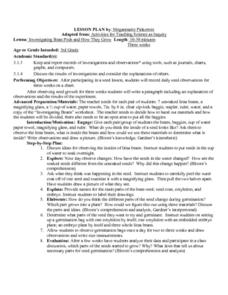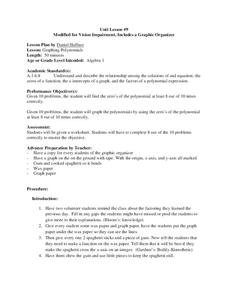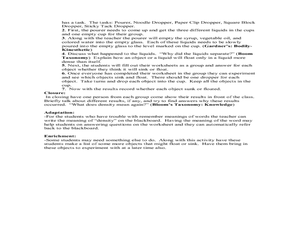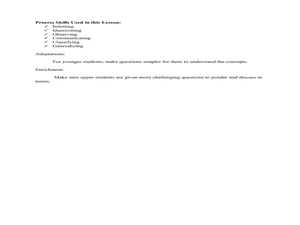Curated OER
Measuring Rainfall and Relationships Between pH, Alkalinity and Suspended Solids in the Pago River
Eleventh graders test the pH and alkalinity of Pago River. In this ecology instructional activity, 11th graders collect data and use spreadsheet to graph results. They analyze and share their findings with the class.
Curated OER
Gingerbread Architecture: An Exploration and Engineering
Eighth graders design and build a gingerbread house. In this technology lesson, 8th graders research the important components of a house. They evaluate the strength of their design and suggest modifications when necessary.
Curated OER
Machines: Designing Form and Function
High schoolers design a boat model with simplified steam engine. In this ecology lesson, students compare renewable and nonrenewable energy sources. They determine the efficiency of their boat model.
Curated OER
Estamos en la granja (We are on the farm)
Students receive a blank farm scene and a baggie of animal cutouts with names on them. They sit back to back so they cannot see each other's farm scene, then place 3-4 animals on their farm scene. They ask each other if their animal is...
Curated OER
Dr. Dirt's Archaeology Lab Artifact Analysis
Learners simulate analyzing artifacts in archaeological lab by using real techniques that archaeologists use. Students practice measuring skills, drawing, writing, and brainstorming, and make inferences based on evidence.
Curated OER
Investigating Bean Pods and How They Grow
Third graders observe and create a record of seed growth over time. After planting a seed, 3rd graders record their observations of the seed's growth over a three week period. Upon conclusion of the experiment, they write a paragraph...
Curated OER
Heat Conductors
Students explore heat conductors. In this lesson on heat, students examine how heat passes through different conductors and how different materials contain heat.
Curated OER
M&M Counting Chart
Students practice classifying objects while utilizing candy. In this sorting instructional activity, students observe an assortment of M&M's and analyze the candy based on color. Students create a color chart based on the number...
Curated OER
How are Seeds Alike and Different?
Second graders examine the seeds in fresh fruit. In this seeds lesson, 2nd graders view different seeds and tell how they are alike and different. Students separate the seeds into groups according to their characteristics.
Curated OER
Word Identification
Students identify grocery items using words on a list. In this grocery word identification lesson, students use a grocery list to choose items from simulated grocery store shelves in their classroom. They work in groups to simulate a...
Curated OER
Sweat Your Socks Off
Fourth graders explore evaporation by conducting an experiment. In this water properties activity, 4th graders examine the differences between two socks that get wet, one which is placed in front of a fan. Students discuss...
Curated OER
Graphing Polynomials
Students graph polynomial equations using different methods. In this algebra lesson plan, students identify the different ways the x and y values relate in a graph. They solve for x by finding the zero's of the polynomials.
Curated OER
Conic Sections
Students explore the different properties of conics. In this algebra lesson, students calculate the midpoint of a line, the distances between two points as they get ready to find the focus and directrix in eclipse and other conics. They...
Curated OER
Liquids: Floating and Sinking
Third graders conduct an experiment. In this floating and sinking liquids lesson, 3rd graders discuss density and investigate it using syrup, vegetable oil and colored water. Students observe the results and complete a worksheet.
Curated OER
The Changing Me
Third graders study the human body. For this health lesson, 3rd graders discuss that everyone's body is growing, measure body parts using a tape measure, and color the body worksheet.
Curated OER
Skeleton
Students study the skeleton. In this human body lesson, students draw and label bones in the body by tracing each other and creating a skeleton out of body parts and brass fastners.
Curated OER
Sounding Out CVCE Words
First graders explore vowels and consonants by participating in a flash card activity. In this phonetics lesson, 1st graders discuss the difference between short and long vowels and identify them within a story told to them by their...
Curated OER
Money and Business (Art)
Third graders investigate world currency by creating their own coin art. For this government lesson, 3rd graders examine the characteristics of different coins and create their own design for a new one. Students discuss and...
Curated OER
The Power of Roman Engineering
Twelfth graders build a replica of the Roman aqueduct. In this Roman engineering lesson students create and label a model of the Roman aqueduct. Students watch a slide-show of the Roman aqueduct ruins.
Curated OER
Function of a Stem
Fourth graders perform an experiment to test the function of a stem. In this science instructional activity, 4th graders write a description of their investigations. Students also explain how the stem interacts with the rest of the...
Curated OER
Topic Sentences and Supporting Facts
Third graders write a paragraph. For this topic sentences lesson students are read the book The Matzah Man: A Passover Story and try Matzah bread in class. Afterward the students write a detailed paragraph about Passover.
Curated OER
Jackie Gore
Students identify the amount of heat given off by solar energy. In this solar energy lesson, students complete an experiment using soil and sand measuring the heat from solar energy.
Curated OER
Heat Energy
Students study how matter changes from solids to liquids or liquids to solids. In this physical science lesson, students discuss heat energy and experiment with heat by changing a candle into a liquid using a hot plate.
Curated OER
Predator vs. Prey
Fifth graders participate in a game to become familiar with predators and preys. For this predator vs. prey lesson, 5th graders ascertain whether a photo shows an organism as a predator or a prey. Students read Killer Creatures....
Other popular searches
- Kinesthetic Learner
- Kinesthetic Math
- Kinesthetic Learner Math
- Literacy Kinesthetic Learner
- Asian History Kinesthetic
- Kinesthetic Learner English
- Kinesthetic Lesson Plans
- Kinesthetic Punctuation
- Kinesthetic Intelligence
- Kinesthetic Math Games
- Kinesthetic Awareness
- Kinesthetic Learner Reading























